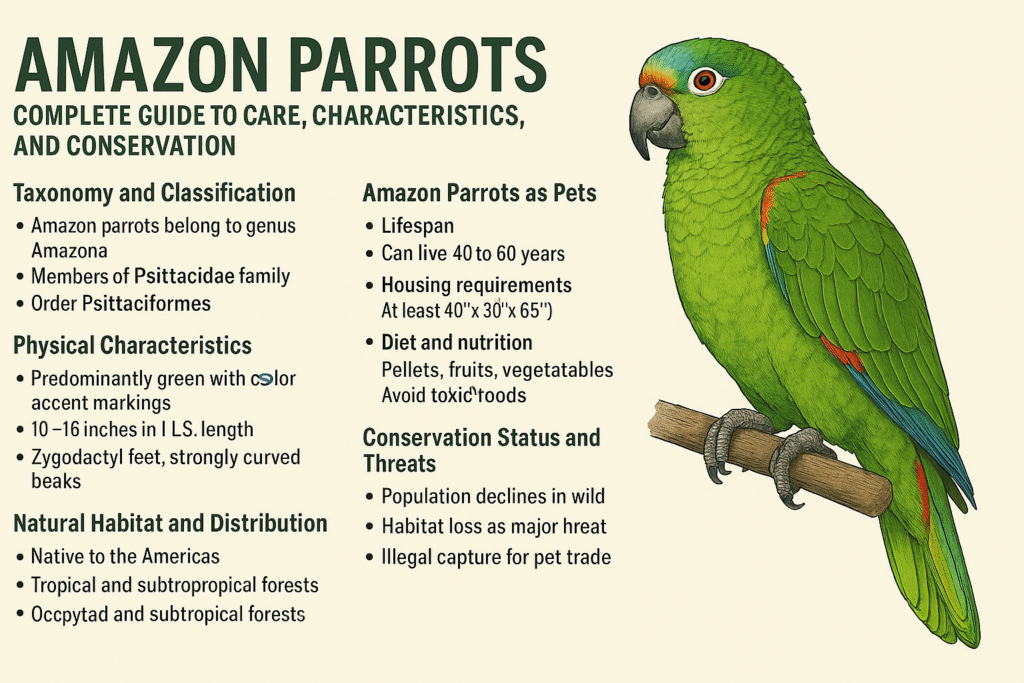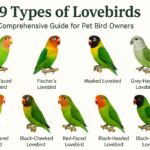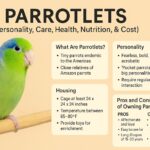Amazon parrots are among the most popular and recognized parrot species in the world. With their vibrant green plumage, colorful accents, remarkable intelligence, and impressive speaking abilities, these medium-sized birds from the Americas have captured the hearts of bird enthusiasts worldwide.
These birds can live for decades in proper care, requiring a significant long-term commitment from owners, but rewarding them with companionship, entertainment, and a special bond that few other pets can provide.
Taxonomy and Classification
Amazon parrots belong to the genus Amazona, which is part of the family Psittacidae, one of three families of true parrots. The genus contains approximately 30 different species1, though some sources mention up to 34 distinct species. These birds are part of the order Psittaciformes, which encompasses all parrots worldwide.
The type species of the genus Amazona is the mealy amazon (Amazona farinosa), which was designated by Italian zoologist Tommaso Salvadori in 1891. The genus name “Amazona” is actually a Latinized version of “Amazone,” a name given to these birds in the 18th century by the Comte de Buffon1.
All Amazon parrots share common characteristics that place them firmly within their taxonomic group, though each species has unique color patterns and slight variations in size. Their classification within the scientific community has helped researchers better understand their evolutionary relationships and biological needs. Understanding these relationships can help owners provide better care specific to Amazon parrots rather than applying general parrot care guidelines.

Physical Characteristics
While Amazon parrots share many common traits, their exact appearance varies by species. Generally, these birds measure between 10 and 16 inches in length and can weigh up to 1.5 pounds. The average Amazon parrot grows to approximately 35 centimeters (about 14 inches) in length.
The predominant color of most Amazon parrots is green, which provides excellent camouflage in their natural forest habitats. However, what makes each species distinctive are the accent colors on their heads, necks, wings, and tails. Depending on the species, these accents may include vibrant yellows, reds, blues, oranges, or whites. For example, the blue-fronted Amazon features blue feathers on its forehead, while the red-lored Amazon has distinctive red patches between its eyes and beak.
Like all parrots, Amazons have strongly curved beaks designed for cracking nuts and seeds. Another distinctive feature is their zygodactyl feet, which have two toes pointing forward and two pointing backward. This unique toe arrangement differs from most other bird species (which typically have three toes forward and one backward) and allows Amazon parrots to grip branches securely and even manipulate food and objects with impressive dexterity.
Natural Habitat and Distribution
Amazon parrots are native exclusively to the Americas, with their range extending from South America through Central America, Mexico, and into the Caribbean islands. Different species have adapted to various ecological niches within this broad geographic range.
These birds inhabit a variety of ecosystems, including tropical rainforests, subtropical forests, savannas, and even some more arid regions. Many species prefer the canopy of dense forests, where they find both food sources and protection from predators. Their green coloration provides excellent camouflage among the leaves.
In their natural habitat, Amazon parrots are typically found in pairs or small flocks, though they may gather in larger groups at feeding or roosting sites. They are generally non-migratory birds, maintaining relatively stable territories throughout the year, though they may move seasonally in search of food sources.
Understanding their natural habitat helps inform proper care in captivity, particularly regarding dietary needs, temperature preferences, and social requirements. Creating an environment that mimics aspects of their natural habitat can help captive Amazon parrots thrive physically and mentally.
Behavior and Intelligence
Amazon parrots are renowned for their remarkable intelligence. They are considered the second most intelligent parrot species in the world, displaying problem-solving abilities, emotional complexity, and impressive communication skills.
One of their most famous traits is their exceptional ability to mimic human speech and other sounds. Amazon parrots are among the best talking birds, with some individuals developing extensive vocabularies. Their intelligence also enables them to understand certain word associations and even use vocalizations appropriately in context.
Beyond their vocal abilities, these parrots exhibit complex social behaviors. In the wild, they form strong pair bonds and maintain intricate social hierarchies within flocks. They engage in mutual grooming, play behaviors, and coordinated foraging activities.
Their intelligence requires mental stimulation, especially in captivity. Without adequate environmental enrichment and social interaction, Amazon parrots can develop behavioral problems, including feather plucking, excessive screaming, or aggression. This high intelligence is both what makes them appealing as companion animals and what makes them challenging to care for properly.
Amazon Parrots as Pets
Lifespan
One of the most significant considerations for potential Amazon parrot owners is their extraordinary lifespan. With proper care, these birds can live between 40 and 60 years. This remarkable longevity means that adopting an Amazon parrot is truly a lifetime commitment, potentially spanning multiple human generations.
Their long lifespan requires owners to make provisions for the bird’s care should the owner predecease the pet. This might involve family members agreeing to assume care responsibilities or establishing arrangements with avian sanctuaries that accept older birds.
Housing Requirements
Amazon parrots require spacious enclosures that allow them to move freely and exercise their wings. The minimum recommended cage size is approximately 40 inches wide by 30 inches deep by 65 inches high. The cage should be constructed of medium-gauge wire strong enough to withstand the powerful beaks of these birds.
Open-top cages with additional perching areas outside the cage are ideal for hand-raised birds, as these allow for greater freedom and interaction with their human family members. Multiple perches of varying diameters should be provided inside the cage to promote foot health and exercise.
At night, the cage should be covered with a sheet or specialized cage cover to prevent drafts and reduce visual stimulation, helping the bird maintain a proper sleep schedule. The cage should be positioned in a room with a stable temperature and away from drafts, direct sunlight, or kitchen fumes, which can be harmful to birds’ sensitive respiratory systems.
Diet and Nutrition
Proper nutrition is essential for maintaining the health of Amazon parrots. In the wild, these birds eat a variety of seeds, nuts, fruits, berries, and vegetation. They actively forage, climbing from branch to branch while searching for food.
For captive Amazon Parrots, a quality commercial pellet formulated specifically for South American parrots should form the foundation of their diet. These pellets are designed to provide balanced nutrition and prevent the selective eating that commonly occurs with seed-only diets.
Daily fresh fruits and vegetables should supplement the pellet diet. Appropriate options include apples, carrots, beans, peas, corn, broccoli, and spinach. It’s important to remove uneaten fresh foods promptly, as spoiled produce can harbor bacteria and yeasts that may cause illness.
Small portions of seed mix can be offered as treats, but these should not replace pellets as the primary food source. Seeds are high in fat and deficient in many essential nutrients, potentially leading to health problems if they constitute too much of the diet.
Some foods are toxic to Amazon parrots and must be avoided entirely. These include avocado, chocolate, caffeine, alcohol, and apple seeds. Lettuce should also be avoided as it provides minimal nutrition and can cause digestive upset.
Vitamin supplements such as Soluvite D or Multivet can be added to drinking water two to three times weekly. Additionally, calcium and iodine can be provided through cuttlebone and iodine bells. Fresh, clean water should always be available and changed daily.
Training and Socialization of Amazon Parrots
Amazon parrots are highly social birds that require regular interaction with their human caregivers. Hand-raised birds, typically removed from their parents at about three weeks of age, are generally more accustomed to human handling and household noises2.
Training should begin early and focus on positive reinforcement techniques. Basic commands, step-up behavior, and appropriate play should be taught consistently. Amazon parrots respond well to praise, attention, and food rewards.
Socialization with various family members is important, as these birds can sometimes become bonded to a single person and aggressive toward others. However, they should also have quiet time daily to prevent overstimulation.
Common Health Issues and Care
Bacterial Diseases
According to avian veterinarians, bacterial infections are among the most commonly diagnosed diseases in Amazon parrots. These infections can affect various body systems, including the respiratory and digestive tracts.
Bacterial infections are easier to prevent than to treat. Providing fresh, non-chlorinated water in appropriate containers (rather than flat, open bowls) is one of the simplest preventive measures5. Regular cage cleaning is also essential to reduce bacterial growth.
Chlamydiosis (psittacosis) is another common bacterial disease affecting Amazon parrots. Symptoms include appetite loss and nasal discharge. This condition requires veterinary treatment with appropriate antibiotics rather than over-the-counter remedies.
Viral Diseases
Amazon parrots are susceptible to several viral diseases, many of which are airborne and challenging to control, particularly in multi-bird environments. Polyoma virus is particularly dangerous, killing baby birds within 24 to 48 hours of infection. Adult birds can carry and transmit the virus without showing symptoms. Fortunately, a vaccine is available to prevent infection.
Papilloma virus, similar to human warts, can also affect Amazon parrots. Veterinarians can surgically remove papillomas from infected birds, though the underlying viral infection may persist.
Nutritional Diseases
Diet-related health problems are common in captive Amazon parrots. Obesity is a significant concern, particularly for birds with limited exercise opportunities. Excess weight can lead to numerous secondary health issues, just as it does in humans.
Seed-based diets often lead to liver problems, including fatty liver syndrome, and vitamin A deficiency. These issues can be prevented by transitioning birds from seeds to a high-quality pellet diet supplemented with appropriate fresh foods.
Regular weight monitoring and dietary adjustments are essential components of preventive health care for Amazon parrots.
Other Health Concerns
Older Amazon parrots may develop benign or malignant tumors5. Regular veterinary examinations can help detect these issues early when treatment is most effective.
Routine preventive care should include regular worming with a broad-spectrum bird dewormer every three months. Annual check-ups with an avian veterinarian are recommended for early detection of potential health problems.
Conservation Status and Threats
The popularity of Amazon parrots as pets has unfortunately contributed to population declines in the wild. Of the approximately 30 species, the International Union for Conservation of Nature (IUCN) lists 9 as Near Threatened, 10 as Vulnerable, 8 as Endangered, and 1 as Critically Endangered.
The primary threats to wild Amazon parrot populations include habitat destruction due to deforestation and illegal capture for the pet trade. Although international regulations like the Convention on International Trade in Endangered Species (CITES) restrict the trade of wild-caught birds, illegal trafficking continues in many areas.
Both the United States and the European Union have implemented regulations making the capture of wild parrots for the pet trade illegal. These measures aim to protect wild populations while encouraging responsible captive breeding programs.
Conservation efforts focus on habitat preservation, enforcement of anti-poaching laws, and public education about the importance of purchasing only legally bred birds from reputable breeders rather than supporting the illegal wildlife trade.
Conclusion
Amazon parrots represent a fascinating group of birds with remarkable intelligence, striking beauty, and complex care requirements. Their long lifespan, combined with their need for mental stimulation and proper nutrition, makes them a significant commitment for potential owners.
While they can make wonderful companion animals when properly cared for, the decision to bring an Amazon parrot into your home should never be made lightly.
Understanding the natural behaviors, physical needs, and potential health issues of these birds is essential for providing appropriate care.
Additionally, awareness of conservation concerns can help guide ethical decisions regarding pet acquisition and support for preservation efforts.
For those prepared to meet their needs, Amazon parrots offer decades of companionship, entertainment, and the unique bond that develops between these intelligent birds and their human caregivers. However, responsible ownership must always consider both the welfare of individual birds and the conservation of wild populations.
- 9 Types of Lovebirds (A Comprehensive Guide for Pet Bird Owners) - June 20, 2025
- Labrador Retriever: America’s Most Beloved Family Dog - June 9, 2025
- The Complete Guide to Indian Ringneck Parrots - June 9, 2025















